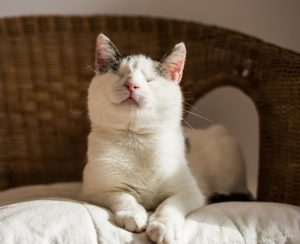Eye drops may be effective in some cases of primary glaucoma, and if not, a surgical approach can be considered. As with any ocular surgery in the veterinary field, general anaesthesia is required. The aim of surgery is to permanently reduce aqueous humour production, create a new artificial drainage pathway or a combination of both.
- Ablation of ciliary processes. It can be done with an external approach by freezing (cryoablation) or laser treatment (trans-scleral laser cyclophotocoagulation). In this way, part of the structures responsible for the production of aqueous humour can be destroyed. Both techniques are not without potential side effects.
- Endoscopic laser cyclophotocoagulation. In this case, the diode laser is used through a tiny endoscopic probe that allows the visualisation and subsequent more precise selective destruction of the ciliary processes from inside the eye. It is often performed at the same time as lens removal by means of phacoemulsification.
- Gonioimplant. It consists of implanting a small tube in the anterior chamber (the area between the cornea and the iris), thus creating an artificial drainage site.
All surgical therapies can be complemented by pharmacological treatment with eye drops.
 In cases where the eye is irreparably blind and causes chronic pain due to ineffective medical/surgical treatment, a surgical approach that may appear drastic must be considered: theenucleation. Glaucoma, in fact, as we never tire of repeating, is a painful disease that negatively affects the quality of life of our four-legged patients.
In cases where the eye is irreparably blind and causes chronic pain due to ineffective medical/surgical treatment, a surgical approach that may appear drastic must be considered: theenucleation. Glaucoma, in fact, as we never tire of repeating, is a painful disease that negatively affects the quality of life of our four-legged patients.
Although signs of pain are often not immediately apparent, owners of animals with chronic intractable glaucoma almost invariably report a dramatic improvement in quality of life following surgical removal of the eye. While this option may be seen as 'excessive' or 'extreme', meeting with quite a bit of resistance from the owner, it is actually the best solution for the well-being of dogs and cats with end-stage painful glaucoma. After all, four-legged patients do not look at themselves in the mirror and their appearance is more of a human concern. In addition, our dogs and cats can have an excellent quality of life and do basically everything they did before glaucoma (even in the case of enucleation of BOTH eyes), as they can rely on their other senses, in particular their sense of smell, much more than humans can.
 Obviously, blindness, especially if it is bilateral, MUST be taken into account by the owner, who must in any case take steps to secure the environment in which their dog or cat lives. Blindness is an event that is generally perceived by the owner as devastating, but in reality we must not forget that much of the information that our dogs and cats receive from the environment is conveyed through smell and hearing, so they adapt very well to blindness, especially if it occurs progressively.
Obviously, blindness, especially if it is bilateral, MUST be taken into account by the owner, who must in any case take steps to secure the environment in which their dog or cat lives. Blindness is an event that is generally perceived by the owner as devastating, but in reality we must not forget that much of the information that our dogs and cats receive from the environment is conveyed through smell and hearing, so they adapt very well to blindness, especially if it occurs progressively.
In selected cases, it is possible to opt for evisceration with implantation of an intraocular prosthesis. This is a surgery in which the intraocular structures (lens, iris, vitreous, retina) are removed to make way for a silicone prosthesis. This allows the globe to be retained as an anatomical structure, making it possible to preserve (at least in part) the aesthetic appearance, something our animal friend may not be very interested in.
Tips for handling your blind pet
In the case of blindness in one's own dog or cat, certain precautions are recommended that can prevent unnecessary stress for one's pets.
- Always try to be reassuring and avoid sudden noises or movements. Ask your guests to speak kindly to your pet before approaching or touching it. This applies especially to children.
- Try to keep the furniture intact and do not leave any obstacles (bags, shoes) scattered on the floor. Make sure there are no dangerous areas (e.g. high steps) that are easily accessible. If your pet is small, consider building a ramp instead of steps.
- Try not to stress your pet too much by taking it into unfamiliar environments. If you have to go somewhere he does not know or if you cannot take him with you on holiday, consider leaving him at home in the company of someone he knows.
- If the dog/cat has access to an area outside the house (e.g. garden) make sure that there are no obstacles and no major changes (new plants, steps, garden equipment left lying around).
- If there are flights of stairs, consider putting up a gate (like a baby gate) so that your pet does not run the risk of falling.
- Try to take your dog for walks always in the same places and with the same routes. Dogs often feel safer with a harness rather than a collar. Remember that an extendable leash could be dangerous. If your pet is only blind in one eye, remember to always stand on his blind side so that he does not have to worry about what happens where he cannot see and can see the world with his 'good' eye. A tip as the owner of a dog bilaterally blind from primary glaucoma: dogs learn at all ages and trust you: my old fox terrier had learnt short walking directions: 'step', 'up', 'down', 'watch out' (sudden obstacle on the pavement). It was harder for me to get used to leading a seeing-eye dog again than for him to learn to be led by me.
- Some blind dogs benefit from the presence of other dogs. Consider getting them a companion, preferably if the new dog is the same size and temperament as yours (so don't go for a rowdy puppy). Contact the kennels, they may be able to help you find a suitable dog.
Daniele Santillo
Dr. Daniele Santillo
Med Vet, CertVOphthal, MRCVS
RCVS Advanced Practitioner in Veterinary Ophthalmology
Arezzo - Santillo short CV
In this section:

